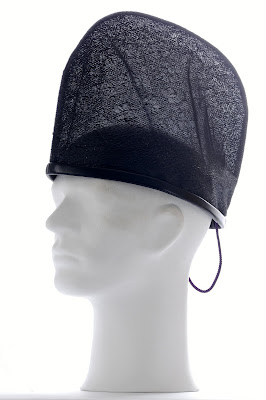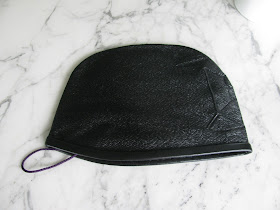Three blue questions remained unanswerd until today. It would be wonderful if one of the readers could help.
See: http://www.kariginu.jp/kikata/2-2.htm
Kanmuri:
This very formal hat dates back to the Heian era (from the late 700s to the end of the 12th century). Originally worn by the nobility on formal occasions, the kanmuri is now part of traditional Shinto priests' clothing. This black, lacquered hat consists of a low cap with a tall knob on the back. A thin wired or lacquered strip of cloth and wooden crossbar are attached to the back of the knob.

Kanmuri:
This very formal hat dates back to the Heian era (from the late 700s to the end of the 12th century). Originally worn by the nobility on formal occasions, the kanmuri is now part of traditional Shinto priests' clothing. This black, lacquered hat consists of a low cap with a tall knob on the back. A thin wired or lacquered strip of cloth and wooden crossbar are attached to the back of the knob.

Pope John XXIII. together with a Shinto priest wearing a Kanmuri
遠紋(三級・斉服用)
Kanmuri X002
During the celebration of Taisai (大祭) ceremonies (major festivals) and Chûsai ceremonies (intermediate-class festivals) all Shinto priests wear a kanmuri.
(1) Open question:
What is the Japanese name of the "tall knob" and the "tale"?
Which signification does these elements have?
© Kanmuri worn by a Shrine-Priest (shinshoku - 神職)
There is one detail to be mentioned:
Shrine priests from the top until the 2nd rang (ni-kyuu) have 4 rhombs on the long tale of the kanmuri.
The priests of the 3rd and 4th rang have two horizontal stripes on the tale of the kanmuri.
-------------------------------------------------------------------------------------------------------------
Eboshi:
"One type of headdress worn by Shinto priests (shinshoku) during ritual ceremonies. Originally a headdress worn to indicate a man who had passed his "coming of age" ceremony (genpuku), the eboshi evolved into heavily lacquered and other various formalized types from the late Heian period; from the early modern period it was rarely worn outside of ritual occasions. Shinto vestments include three types, "formal vestments" (seisō), "ritual vestments" (reisō), and "ordinary vestments" (jōsō); of these, the eboshi is worn by male priests as part of the class of "ordinary vestments" which includes the robes called kariginu and jōe. (See Seisō, reisō , jōsō.)."
"One type of headdress worn by Shinto priests (shinshoku) during ritual ceremonies. Originally a headdress worn to indicate a man who had passed his "coming of age" ceremony (genpuku), the eboshi evolved into heavily lacquered and other various formalized types from the late Heian period; from the early modern period it was rarely worn outside of ritual occasions. Shinto vestments include three types, "formal vestments" (seisō), "ritual vestments" (reisō), and "ordinary vestments" (jōsō); of these, the eboshi is worn by male priests as part of the class of "ordinary vestments" which includes the robes called kariginu and jōe. (See Seisō, reisō , jōsō.)."

風折烏帽子 本皮縁
(本絞丸縁張貫)
Eboshi E160 firm
During the shôsai (minor festivals) all Shinto priests wear the eboshi.
The eboshi is either made of firm or soft and transparent material.
In this case the hierarchy of the priests will be distiguished by the hakama (袴 - culottes).
The eboshi made of soft and light weight materal is more comfortable to wear than the firm model.
More often a paper cord is used to fix the hat and to assure higher hygiene.
During the shôsai (minor festivals) all Shinto priests wear the eboshi.
The eboshi is either made of firm or soft and transparent material.
In this case the hierarchy of the priests will be distiguished by the hakama (袴 - culottes).
The eboshi made of soft and light weight materal is more comfortable to wear than the firm model.
More often a paper cord is used to fix the hat and to assure higher hygiene.
-------------------------------------------------------------------------------------------------------------
立烏帽子(懸緒紙捻付 紙箱入)
本絞丸縁張貫
懐中用烏帽子: Kaichu yo Eboshi
本皮縁 裏付
Eboshi E040 soft and transparent, very light weight
懐中用烏帽子
引立烏帽子 (白鉢巻付)
Eboshi E080 light weight and transparent
2 white ribbons
This kind of eboshi is worn by priest cadidates
(3) Open question:
What is the sense of the two white ribbons?



































The white ribbons are used to secure the eboshi to the head by tightening the headband.
ReplyDeleteThe parts of the kanmuri are labeled on this page
ReplyDeletehttp://www.iz2.or.jp/english/fukusyoku/wayou/3.htm